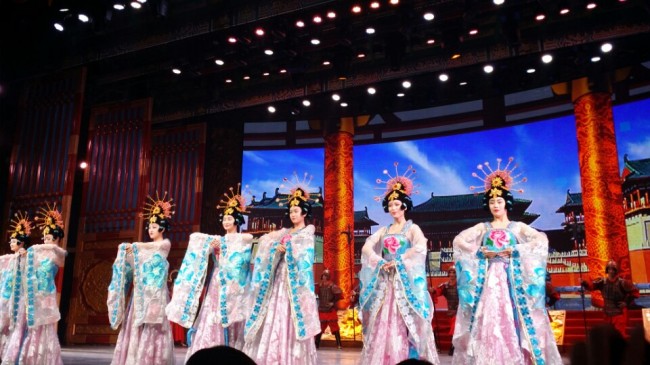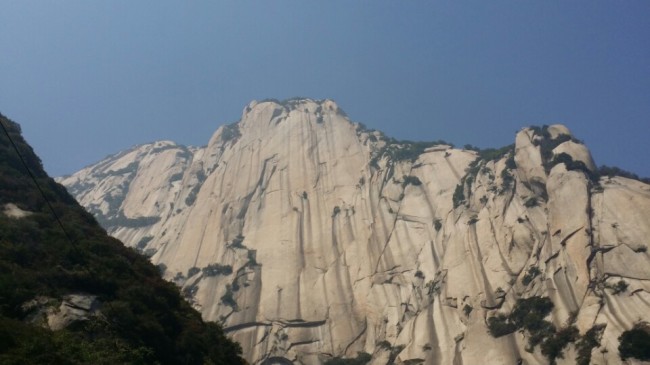SHAANXI PROVINCE, China -- Many cities in China epitomize the country’s economic prosperity and rich history. Shanghai’s skyscraper-lined Pudong district displays Western-style modernity, while Gulin’s picturesque mountain villages demonstrate its ancient beauty.
But Xian in China’s northwest has withstood the test of time as the juncture where ancient and modern China intersect.
Filled with tourist attractions boasting China’s cultural diversity, Xian has arguably withstood the test of time. Its sights range from historic spots recalling the era of Changan -- the city’s old name -- where as many as 11 dynasties rose and fell through more than a millennia, to ever-changing urban landscapes largely shaped by the Shaanxi province capital city’s pursuit of economic prosperity.
Xian’s “hybrid” beauty is best appreciated at City Wall. One of the most intact walls in China, a 650-year-old edifice towers over the bustling city lined with dazzling luxury shopping malls and relics of the Chinese past dynasties such as Drum Tower and Bell Tower from Ming Dynasty.
The wall is so wide that its lookout post can accommodate more than eight buses. It takes a good two hours to bike along the wall’s entire 13.7-kilometer stretch.
But Xian in China’s northwest has withstood the test of time as the juncture where ancient and modern China intersect.
Filled with tourist attractions boasting China’s cultural diversity, Xian has arguably withstood the test of time. Its sights range from historic spots recalling the era of Changan -- the city’s old name -- where as many as 11 dynasties rose and fell through more than a millennia, to ever-changing urban landscapes largely shaped by the Shaanxi province capital city’s pursuit of economic prosperity.
Xian’s “hybrid” beauty is best appreciated at City Wall. One of the most intact walls in China, a 650-year-old edifice towers over the bustling city lined with dazzling luxury shopping malls and relics of the Chinese past dynasties such as Drum Tower and Bell Tower from Ming Dynasty.
The wall is so wide that its lookout post can accommodate more than eight buses. It takes a good two hours to bike along the wall’s entire 13.7-kilometer stretch.

“The wall used to be considered as a liability for Xian people in modern times when people pursued urban construction and economic development. Now Xian residents have so much pride in it,” said Luo Yu-ying, a 40-year-old tour guide who is native to Xian.
The residents’ pride in Xian’s cultural heritage was expressed in the form of arts. Among numerous venues for arts exhibitions and musical performances, a costume show featuring Tang Dynasty clothing perhaps best encompasses the city’s tradition.
Featuring a range of costumes from elegant clothes of concubines and warriors to the flamboyant ones that would have been favored by the emperor, the show skillfully reenacts the lives of those who had lived during the Tang Dynasty’s pinnacle as the biggest state in the world.
Before the show starts, the audience can enjoy a dumpling buffet. Stuffed with a variety of ingredients such as beef, pork, chicken, duck, walnuts and sweet potato, the dishes are shared and served in a bowl to bring luck to those who eat them.
“If you get one dumpling in your serving of a bowl, it means blessing. If you get two, then it means double blessing. If you get three, then it gets better and better. If you get four, you will become rich. If you don’t get any dumplings, it is OK because it means you are safe,” the waitress at the buffet explained.
The city’s back alley offers another glimpse of Xian’s cultural diversity. Located beside Drum Tower and Bell Tower -- well-preserved historic relics from the Ming Dynasty -- the Muslim Quarter, otherwise known as Beiyuanmen Street, seems like an endless labyrinth of local delicacies and unique stores.

Dotted throughout are a number of other attractions like the Xian Great Mosque, the oldest one in China built in A.D. 742 during the Tang Dynasty and later constructed and expanded during Ming and Qing Dynasty, the Muslim neighborhood is lined with food vendors selling local delicacies.
Among the food, the most popular one is lamb kebab, or yang rou chuan in Chinese. Coated in salt, chili flakes and ground cumin, skewered lamb pieces are barbecued over charcoal. Fresh squid, mackerel, eggplant and potatoes are among other food that can be barbecued.
Outside the city stands one of China’s famous mountains that serves as icing on the cake to the city’s cultural diversity. Located near Huayin, a city about 120 kilometers east of Xian, Hua Shan Mountain attracts visitors with its awe-inspiring ranges and rock formations.
Regarded as one of China’s Five Great Mountains alongside Tai Shan in Shandong province, two Heng Shans in Hunan and Shanxi province and Song Shan in Henan province, Hua Shan is home to prominent Taoist temples where many followers had practiced Taoism in the past.
Despite its reputation in ancient times for reclusiveness and inaccessibility – the mountain towers past 2,000 meters -- people can now easily reach the top with the help of a cable car in just 10 minutes.
By Yeo Jun-suk, Korea Herald correspondent(jasonyeo@heraldcorp.com)







![[KH Explains] Hyundai's full hybrid edge to pay off amid slow transition to pure EVs](http://res.heraldm.com/phpwas/restmb_idxmake.php?idx=644&simg=/content/image/2024/04/18/20240418050645_0.jpg&u=20240419100350)






![[From the Scene] Monks, Buddhists hail return of remains of Buddhas](http://res.heraldm.com/phpwas/restmb_idxmake.php?idx=652&simg=/content/image/2024/04/19/20240419050617_0.jpg&u=20240419175937)

![[KH Explains] Hyundai's full hybrid edge to pay off amid slow transition to pure EVs](http://res.heraldm.com/phpwas/restmb_idxmake.php?idx=652&simg=/content/image/2024/04/18/20240418050645_0.jpg&u=20240419100350)

![[Today’s K-pop] Illit drops debut single remix](http://res.heraldm.com/phpwas/restmb_idxmake.php?idx=642&simg=/content/image/2024/04/19/20240419050612_0.jpg&u=)